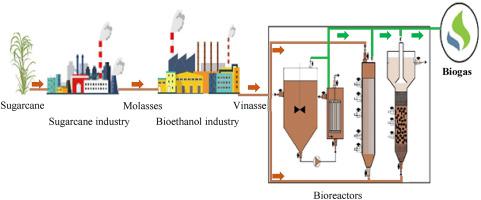Biomass & Bioenergy ( IF 6 ) Pub Date : 2022-04-27 , DOI: 10.1016/j.biombioe.2022.106446 Mostafa Kiani Deh Kiani 1 , Mostafa Parsaee 1 , Seyed Mohammad Safieddin Ardebili 1 , Ileana Pereda Reyes 2 , Lucas Tadeu Fuess 3 , Keikhosro Karimi 4, 5

|
The major wastewater of ethanol production plants from sugarcane, i.e., vinasse, is a severe environmental pollutant and challenges sustainable cane-based biofuel production. The potential of anaerobic digestion (AD) of vinasse is well demonstrated; however, the digestion process requires special operational conditions that severely affect biodegradation. The main affecting parameters are pH, temperature, nutrients, carbon-to-nitrogen ratio, and the presence of inhibitors. Besides, oxidation-reduction potential, hydraulic retention time (HRT), organic loading rate (OLR), mixing, and reactor configurations are among the influencing factors. In this study, the effects of reactor configurations on biogas production from vinasse are comprehensively investigated, and the perspectives are discussed. The up-flow anaerobic sludge blanket, expanded granular sludge bed, fixed bed reactor (packed-bed and structured-bed), and hybrid anaerobic reactor are configurations used for vinasse treatment. The up-flow anaerobic sludge blanket, the most popular reactor used, has a high reaction rate and performance at low HRT levels; however, washout and reactor stability are typical issues in industrial-scale applications. Among single-stage reactors, hybrid anaerobic reactor configurations have more stability and high performance. Despite enormous efforts, more studies need to optimize the operating conditions and more information at pilot scale is necessary for the industrialization of the processes.
中文翻译:

从甘蔗酒糟生产沼气的不同生物反应器配置:综合综述
甘蔗乙醇生产厂的主要废水,即酒糟,是一种严重的环境污染物,对可持续的甘蔗生物燃料生产提出了挑战。酒糟厌氧消化 (AD) 的潜力已得到充分证明;然而,消化过程需要严重影响生物降解的特殊操作条件。主要影响参数是 pH 值、温度、营养物质、碳氮比和抑制剂的存在。此外,氧化还原电位、水力停留时间(HRT)、有机负载率(OLR)、混合和反应器配置都是影响因素。在这项研究中,全面研究了反应器配置对酒糟产生沼气的影响,并讨论了这些观点。上流式厌氧污泥层,膨胀颗粒污泥床、固定床反应器(填充床和结构床)和混合厌氧反应器是用于酒糟处理的配置。上流式厌氧污泥层是最常用的反应器,在低 HRT 水平下具有高反应速率和性能;然而,冲洗和反应器稳定性是工业规模应用中的典型问题。在单级反应器中,混合厌氧反应器配置具有更高的稳定性和高性能。尽管付出了巨大的努力,但需要更多的研究来优化操作条件,并且中试规模的更多信息对于工艺的工业化是必要的。最常用的反应器,在低 HRT 水平下具有高反应速率和性能;然而,冲洗和反应器稳定性是工业规模应用中的典型问题。在单级反应器中,混合厌氧反应器配置具有更高的稳定性和高性能。尽管付出了巨大的努力,但需要更多的研究来优化操作条件,并且中试规模的更多信息对于工艺的工业化是必要的。最常用的反应器,在低 HRT 水平下具有高反应速率和性能;然而,冲洗和反应器稳定性是工业规模应用中的典型问题。在单级反应器中,混合厌氧反应器配置具有更高的稳定性和高性能。尽管付出了巨大的努力,但需要更多的研究来优化操作条件,并且中试规模的更多信息对于工艺的工业化是必要的。


























 京公网安备 11010802027423号
京公网安备 11010802027423号